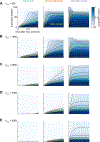Neural Circuits for Fast Poisson Compressed Sensing in the Olfactory Bulb
- PMID: 40376274
- PMCID: PMC12079577
Neural Circuits for Fast Poisson Compressed Sensing in the Olfactory Bulb
Abstract
Within a single sniff, the mammalian olfactory system can decode the identity and concentration of odorants wafted on turbulent plumes of air. Yet, it must do so given access only to the noisy, dimensionally-reduced representation of the odor world provided by olfactory receptor neurons. As a result, the olfactory system must solve a compressed sensing problem, relying on the fact that only a handful of the millions of possible odorants are present in a given scene. Inspired by this principle, past works have proposed normative compressed sensing models for olfactory decoding. However, these models have not captured the unique anatomy and physiology of the olfactory bulb, nor have they shown that sensing can be achieved within the 100-millisecond timescale of a single sniff. Here, we propose a rate-based Poisson compressed sensing circuit model for the olfactory bulb. This model maps onto the neuron classes of the olfactory bulb, and recapitulates salient features of their connectivity and physiology. For circuit sizes comparable to the human olfactory bulb, we show that this model can accurately detect tens of odors within the timescale of a single sniff. We also show that this model can perform Bayesian posterior sampling for accurate uncertainty estimation. Fast inference is possible only if the geometry of the neural code is chosen to match receptor properties, yielding a distributed neural code that is not axis-aligned to individual odor identities. Our results illustrate how normative modeling can help us map function onto specific neural circuits to generate new hypotheses.
Figures








Update of
-
Neural Circuits for Fast Poisson Compressed Sensing in the Olfactory Bulb.bioRxiv [Preprint]. 2023 Oct 28:2023.06.21.545947. doi: 10.1101/2023.06.21.545947. bioRxiv. 2023. Update in: Adv Neural Inf Process Syst. 2023;36:64793-64828. PMID: 37961548 Free PMC article. Updated. Preprint.
Similar articles
-
Neural Circuits for Fast Poisson Compressed Sensing in the Olfactory Bulb.bioRxiv [Preprint]. 2023 Oct 28:2023.06.21.545947. doi: 10.1101/2023.06.21.545947. bioRxiv. 2023. Update in: Adv Neural Inf Process Syst. 2023;36:64793-64828. PMID: 37961548 Free PMC article. Updated. Preprint.
-
Task-Demand-Dependent Neural Representation of Odor Information in the Olfactory Bulb and Posterior Piriform Cortex.J Neurosci. 2019 Dec 11;39(50):10002-10018. doi: 10.1523/JNEUROSCI.1234-19.2019. Epub 2019 Oct 31. J Neurosci. 2019. PMID: 31672791 Free PMC article.
-
Performance of a Computational Model of the Mammalian Olfactory System.In: Persaud KC, Marco S, Gutiérrez-Gálvez A, editors. Neuromorphic Olfaction. Boca Raton (FL): CRC Press/Taylor & Francis; 2013. Chapter 6. In: Persaud KC, Marco S, Gutiérrez-Gálvez A, editors. Neuromorphic Olfaction. Boca Raton (FL): CRC Press/Taylor & Francis; 2013. Chapter 6. PMID: 26042330 Free Books & Documents. Review.
-
A spiking neural network model of self-organized pattern recognition in the early mammalian olfactory system.Front Neural Circuits. 2014 Feb 7;8:5. doi: 10.3389/fncir.2014.00005. eCollection 2014. Front Neural Circuits. 2014. PMID: 24570657 Free PMC article.
-
Engineering Aspects of Olfaction.In: Persaud KC, Marco S, Gutiérrez-Gálvez A, editors. Neuromorphic Olfaction. Boca Raton (FL): CRC Press/Taylor & Francis; 2013. Chapter 1. In: Persaud KC, Marco S, Gutiérrez-Gálvez A, editors. Neuromorphic Olfaction. Boca Raton (FL): CRC Press/Taylor & Francis; 2013. Chapter 1. PMID: 26042329 Free Books & Documents. Review.
Cited by
-
Predictive coding in the human olfactory system.Trends Cogn Sci. 2025 Sep;29(9):814-826. doi: 10.1016/j.tics.2025.04.005. Epub 2025 May 8. Trends Cogn Sci. 2025. PMID: 40345946 Review.
-
Amplification of olfactory transduction currents implements sparse stimulus encoding.bioRxiv [Preprint]. 2024 Oct 12:2024.10.11.617893. doi: 10.1101/2024.10.11.617893. bioRxiv. 2024. Update in: J Neurosci. 2025 Mar 17:e2008242025. doi: 10.1523/JNEUROSCI.2008-24.2025. PMID: 39416025 Free PMC article. Updated. Preprint.
-
Interpretable deep learning for deconvolutional analysis of neural signals.bioRxiv [Preprint]. 2024 Dec 2:2024.01.05.574379. doi: 10.1101/2024.01.05.574379. bioRxiv. 2024. Update in: Neuron. 2025 Apr 16;113(8):1151-1168.e13. doi: 10.1016/j.neuron.2025.02.006. PMID: 38260512 Free PMC article. Updated. Preprint.
-
Combining Sampling Methods with Attractor Dynamics in Spiking Models of Head-Direction Systems.bioRxiv [Preprint]. 2025 Feb 26:2025.02.25.640158. doi: 10.1101/2025.02.25.640158. bioRxiv. 2025. PMID: 40060526 Free PMC article. Preprint.
References
-
- von Uexküll Jakob Johann. Umwelt und Innenwelt der Tiere. Springer, 1909. doi:10.1007/978-3-662-24819-5. - DOI
-
- Yong Ed. An Immense World: How Animal Senses Reveal the Hidden Realms Around Us. Random House, New York, first edition, 2022. ISBN 9780593133231.
Grants and funding
LinkOut - more resources
Full Text Sources
Research Materials
Miscellaneous
